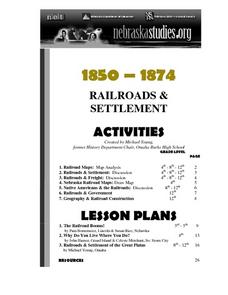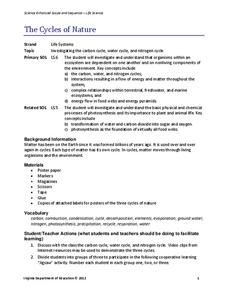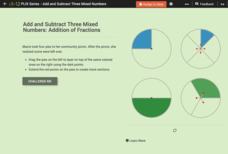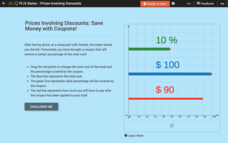K12 Reader
Civil Rights Biography: Dr. Martin Luther King, Jr.
Introduce your class to Dr. Martin Luther King, Jr. and his many accomplishments through a one-page biography. Class members read the text and respond to three questions included at the end.
Curated OER
Author Study: Cynthia Rylant
Explore the life's work of one of the great children's authors using this ten-lesson author study unit. After first performing some whole-group research into the life of Cynthia Rylant, the class goes on to read six different stories,...
US House of Representatives
Congresswomen in an Age of National Crises, 1935–1954
Class members investigate congresswomen and the role these senators and representatives played in congress during the period from 1935–1954.
K20 LEARN
Show Me Your Credentials: Voting In America
The debate over voting rights continues. To begin their study of voting rights, class members first vote on proposed new classroom rules. After a discussion of the activity, groups are given a copy of the 1965 Alabama Literacy Test and...
Curated OER
Funding a Way to the Top
Review economic vocabulary, presidential election campaigns, and current campaign budgets (2004). Your class will determine how they feel about the amount of money spent on presidential campaigns, they will read an informational article,...
Curated OER
The Railroads and Settlement of the Great Plains
Enhance your American literature unit with this resource, in which readers access the Nebraska Studies website and read about "Railroads and Settlement." They search for a photograph of some aspect of the railroad from the Prairie...
Curated OER
What Makes the Writer Write
Your 11th and 12th graders are ready to critique society! Channel that inclination by studying a novel that offers social criticism of other eras (book recommendations included). This resource presents a well-thought-out overview of such...
Curated OER
Two Views of the Slave Ship Brookes
Actual ship diagrams and a table of voyage data gives young historians an authentic glimpse of on-board experiences during the Atlantic Slave Trade. The class examines a projected diagram of the slave ship Brooks, recording thoughts....
University of Arizona
Identity Repair
In a detailed, creative writing task, potential poets analyze how race, identity, and society categorize and (mis)represent us. The learning begins with an imaginative anticipatory set where students describe unique situations that their...
Pulitzer Center
International Aid and Fragile States
"States suffering from internal conflict, weak infrastructures, lack of economic development, and general instability are emerging as a large threat to the international security." What factors contribute to the creation of a fragile...
King County
Reproductive System
It's every health and science teacher's favorite subject to cover: the reproductive system. This comprehensive lesson introduces adolescents to the reproductive anatomy of men and women with the help of a series of diagrams, discussions,...
Museum of Disability
The Right Dog for the Job
Here, dog lovers can enjoy an educational lesson about the ways puppies are trained to become service and guide dogs. Based on The Right Dog for the Job by Dorothy Hinshaw Patent, the lesson provides discussion questions for learners...
It's About Time
The Changing Geography of Your Community
Lead your class in exploring their local communities as well as the general environment. As they determine continental distributions by investigating minerals, rocks, and fossils located in their local region, pupils construct a...
Novelinks
Tuck Everlasting: Herber Readiness
Begin your unit on Natalie Babbitt's Tuck Everlasting with a pre-reading activity about the novel's themes. As class members ponder five questions that reflect the book's themes, they talk about their opinions in a class discussion.
It's About Time
What Determines and Limits an Atom's Mass?
Provide learners with the tools to further understand nuclear energy and isotopes. Young chemists investigate the components of an atom's nucleus, use symbols to represent various isotope forms, and use the percent abundance of an atom's...
Virginia Department of Education
The Cycles of Nature
Encourage peer collaboration and assist with the creation of visual aids to identify carbon, water, and nitrogen cycles as your class learns more about nature. They discuss relative information, create a visual aid depicting the chosen...
Stanford University
Solstice and Equinox Season Model
How can December 21 be the shortest day of the year when all days are 24 hours long? Pupils see how to build a model showing the differences between winter and summer solstices and equinoxes. Using this model, classes can then discuss...
National Institute of Open Schooling
Electrochemistry
In an electrolytic cell, electrical energy is converted into chemical energy, the exact opposite of a battery! Lesson 15 in a series of 36 explores electrochemistry. Participants begin by reading and discussing oxidation/reduction...
EngageNY
Posing Statistical Questions
Is this a statistical question? The opening lesson in a series of 22 introduces the concept of statistical questions. Class members discuss different questions and determine whether they are statistical or not, then they sort the data...
CK-12 Foundation
Addition of Fractions
Five word-problems challenge mathematicians to add fractions. Interactive fraction circles assist scholars in problem-solving. Question types include multiple-choice, true or false, and a discussion.
CK-12 Foundation
Prices Involving Discounts: Save Money with Coupons!
Nine questions make up an interactive that challenges scholars to identify new prices after discounts. Question types include fill in the blank and multiple choice. A fully-functional tool assists participants in solving word problems....
Acoustical Society of America
Sound Measures
How loud is the class's hearing threshold? Using a sound level meter, the class members observe how the loudness of sound is affected by distance. Learners continue to study decibels by seeing how different sounds compare to each other...
Missouri Department of Elementary
Celebrate Your Culture
After a class discussion about celebrations and customs, class members draw pictures depicting special events from their family cultures. Next, they draw pictures of an event from a different culture and share their work with classmates.
Nemours KidsHealth
Smoking: Grades 6-8
Light up middle schoolers' understanding of the monetary and health costs of smoking with two activities. First, class members calculate how much a smoker would spend in a year if they smoke a pack a week or a day. They then explore...
Other popular searches
- Class Discussion Plans
- Fishbowl Class Discussion
- Class Discussion Topics
- Whole Class Discussion
- Class Discussion Rubrics
- Science Class Discussion
- History Class Discussion
- Class Discussions Hiroshima
- Leading Class Discussions

























